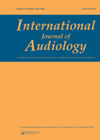
Journal Reviews
Which cross-over frequency is best for electro-acoustic stimulation?
Advances in technology and improved soft surgical techniques have led to individuals with better hearing thresholds, especially at the low frequencies, becoming candidates for cochlear implants (CI). Surgeons are more confident that residual hearing can be preserved thus making those...
Listening effort and speech perception performance
Capturing speech perception performance in noisy listening environments is a key part in validating any hearing instrument. Traditionally audiologists have always measured this performance in noisy environments by looking at thresholds, i.e. speech reception thresholds or signal to noise ratios....
Inter-aural hearing preservation in cochlear implantation
Hearing preservation during cochlear implantation is becoming increasingly important, although results can be unpredictable. NICE are in the process of updating their guidance in the UK and it is possible that those with better hearing than the current candidates will...
The DOSO outcome measure
The subjective outcome measures are a crucial element of the auditory rehabilitation process for hearing aid fitting. Authors hypothesised that normative data used for the device-orientated subjective outcome (DOSO) were no longer valid for new hearing aids technologies (2015-era technologies)....
Social representation of hearing loss in different countries
The social representation of different phenomena has generated strong interest among researchers recently. The social representation of ‘hearing loss’ is different in different countries such as India, Iran, Portugal, and the UK, as was evidenced in previous research. This study...
Sound localisation after bilateral cochlear implantation
Limited information is known about the localisation skills of paediatric cochlear implant patients who were good hearing aid users before their hearing deteriorated. As localisation is a skill often associated with good natural hearing, there is a worry that implants...
Management of patients with advanced otosclerosis
This paper discusses the management options of advanced otosclerosis. There are several definitions for advanced otosclerosis in the literature but, more recently, the diagnosis of advanced otoscletosis has been reserved for patients who have less than 30% aided speech discrimination...
Hearing loss and QOL
This article evaluates the impact of hearing loss and its rehabilitation on the quality of life (QoL) of adults. The authors suggest that the currently used scale, Aphab, is long, complicated and does not take into account minor changes. The...
Directional microphones and speech
This study aimed to research how speech recognition, listening effort and localisation depends on hearing aids’ microphone configuration in people with moderate to severe hearing losses. Eighteen participants with sensorineural, symmetrical, moderate to severe hearing loss were tested. Participants were...
Self-report of hearing aids handling difficulties
The authors have raised an interesting subject concerning the ability of customers to self-assess their hearing aid handling skills. Previous studies showed that 96% of customers when asked if they are able to manage their hearing aids answered ‘yes’. However,...
Commercial desiccants or uncooked rice?
Moisture can damage any electronic devices including hearing aids. It is commonly known that rice can ‘rescue’ an electronic device if wetted. Authors of the below-described study researched whether uncooked rice could be used as an efficient equivalent to often...
Literature review of experience with the BAHA Attract implant
The authors undertook a literature review for reports on patients who underwent BAHA Attract implantation. Of the 497 PubMed articles, 10 studies met their inclusion criteria. All the studies published were observational studies. There were no randomised control trials. The...














